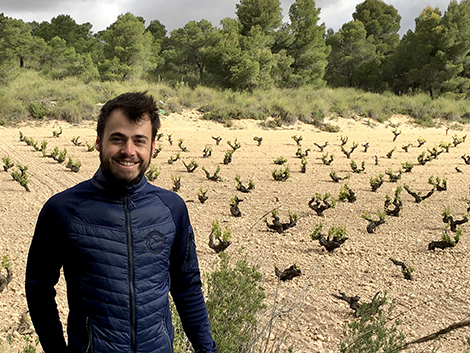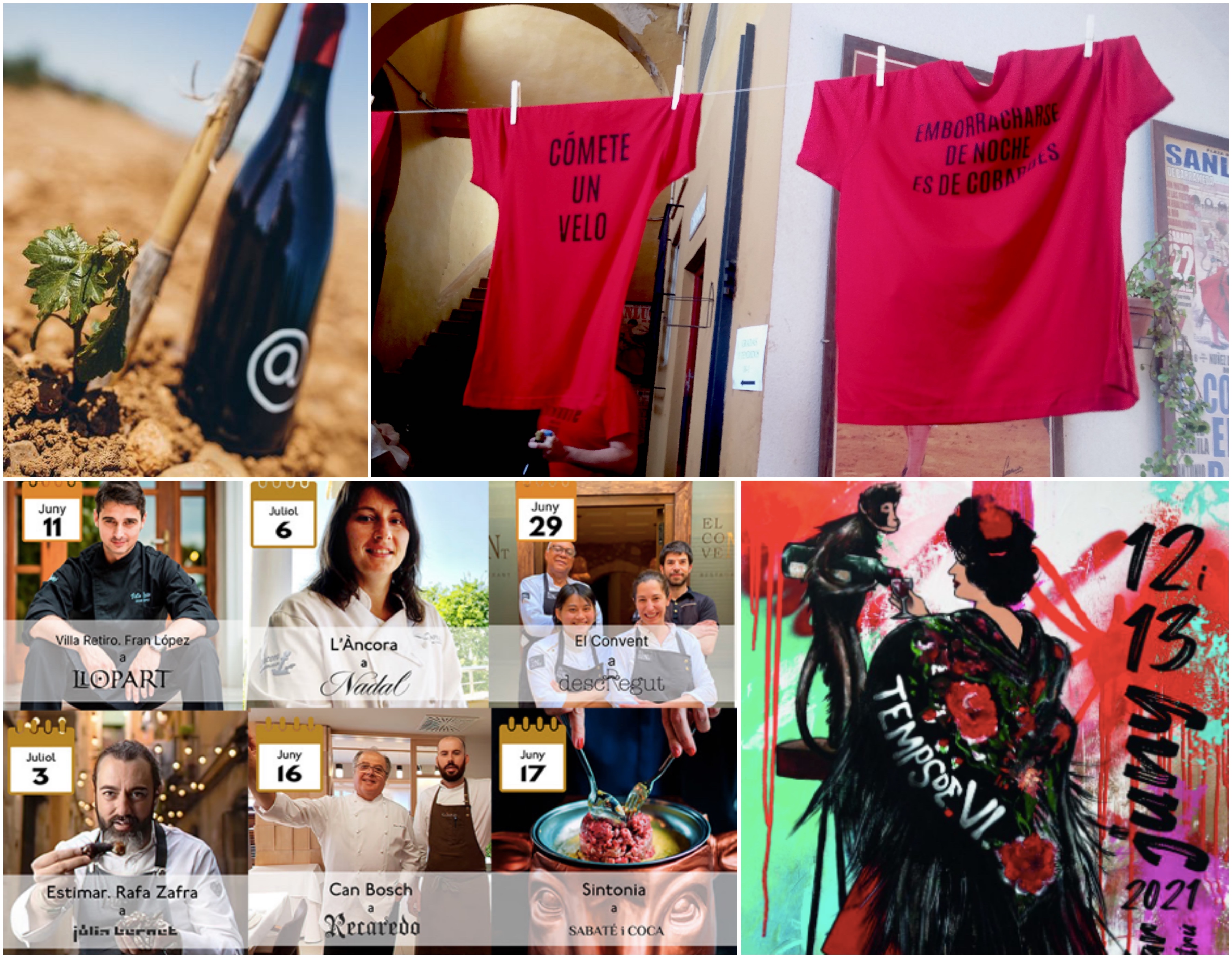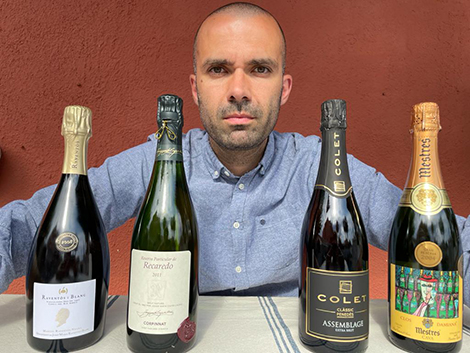
Terroir is knocking on Jumilla’s door. After shifting from bulk to bottled wine, it is now time to capture its distinctive landscapes. The Cerdán family, who pioneered organic farming in this area of Spain’s southeast, has a clear idea of what comes next for a region that boasts a rich heritage of old, ungrafted vineyards.
Juanjo Cerdán, fourth generation together with siblings Lucía and Carlos, tells the story of how smallholdings originated in Fuente Álamo (Albacete), the village where his family settled decades ago. It dates back to the days after Spain’s land confiscations in the early 19th century, when, facing a lack of cash flow, landowners gave some of their worst sites to labourers. These were mostly terraced or had poor soils in elevated areas that were difficult to tend. As almond and olive trees were more prone to frost, vines were the chosen crop hence viticulture practices were unproductive and somewhat extreme.
"Each family had a small cellar of their own where they produced three or four tinajas, which they used to sell in Alicante and Jumilla. At the end of the 19th century, my great-grandparents farmed small plots -barely 0.2 and 0.3 hectares," Juanjo points out as we tour some of Cerrón’s most significant vineyards.
His grandparents lived through the Civil War and witnessed the emergence of the cooperative movement in the 1950s. Wine, which was made at home until then, was now being blended in large tanks. According to Juanjo, the wine produced at the Fuente Álamo cooperative was well regarded. Given the village's elevation and the diversity of soils, it was possible to produce harmonious reds with a good balance between alcohol and acidity.
Traditional vineyards
Located at an elevation of 950 metres above sea level, El Cenajo is a good example of "del terreno" vineyards, as ungrafted Monastrell vines are called locally. Other grapes like Blanquilla, Rojal or Forcallat (this one was relatively widespread in the past) are also present in these old plots. El Cenajo was planted in the 1940s with massal selection, the customary practice at the time. After being stored in water during the winter, cuttings were buried in the spring in pits measuring one metre by one metre with some compost. Very importantly, the roots had to be planted in an “L” shape and pointing northwards (see photo below) so they could have enough moisture. It was the best way to prevent the plant from drying out. Pruning was very short ("bonsai-like", says Juanjo) so that, in such a hot, dry climate, the vines spent as little energy as possible avoiding the stress of the summer.

The grapes picked at El Cenajo and those from a second site called La Muela are destined to La Servil, the most affordable wine (€19 at Decantalo in Spain) within Cerrón's Stratum Wines range. All the wines within this range come from old, ungrafted vineyards. Most of them are single-vineyard wines made in limited quantities and presented in Burgundy-style bottles. The first 2019 vintage is sold out and the 2020s are expected to be bottled in October or November.
Everything started with Chardonnay
Getting to this stage has not been easy, particularly for the third generation. Strong advocates of sustainability, reforestation and cooperation with environmental associations, Juanjo and Juani were sorely misunderstood when they requested organic certification in the 1990s (at present, most of Jumilla's vineyards are organically farmed). As the local cooperative refused their request to handle their grapes separately, they set up on their own and became suppliers to a private winery while renting a small space to start producing their own wines. The first one was Viña Cerrón Chardonnay whose 2,000 bottles took them almost three years to sell. It was followed by Remordimiento (remorse), a blend of Monastrell, Tempranillo and Syrah. The name tried to express their doubts as to whether they would be able to carry their project through.
Oddly enough, Chardonnay is now the entry level wine whereas the local, unglamourous Airén makes it to the top within the Stratum range. In the 1990s, they planted a considerable number of hectares with international grapes (Chardonnay, Petit Verdot, Cabernet, Merlot or Syrah) to contend with the low prices paid for Monastrell at the time. These now account for just over 10 of the family's own 32 hectares. I must confess that the wine that put me on this producer's trail was Rabia Petit Verdot. I was struck by the freshness and balance achieved with a variety that can easily turn powerful and overwhelming in southern latitudes. I wondered: if the Petit Verdot is this good, what will the Monastrell be like? In fact, Monastrell is their flagship grape variety. They own 20 hectares and rent almost 10 more of old, traditional vines.

A significant number of Cerrón's own vineyards surround the winery, built in an original Greek cross plan. It is beautifully blended with the landscape and accessed through a pathway lined with cypress trees on one side only (the other side belongs to another owner). The wide variety of wine vessels (oak, concrete, stainless steel, tinajas, foudres, etc.) and barrel sizes used to ferment and age the wines are placed around a central space, so everything is visible at a quick glance. The ageing area, like the roots of ungrafted vines, is oriented to the north. Perhaps Bodegas Cerrón's main merit is the fact that oak goes unnoticed inalmost all their wines. This is a welcome change in the face of some excesses that often hinder the true expression of Jumilla's reds.
Bodegas Cerrón produces around 110,000 bottles of organic wines annually. The entry-level wines are Todo sobre mí Chardonnay (All About Me, €7.90 at Bodegas Bio, 14,000 bottles) and the El Tiempo que nos une Monastrell (Time brings us together, €7.70, 20,000 bottles). The red is fermented in oak and concrete vats and undergoes malolactic fermentation in an oak vat. Next comes Remordimiento, Juanjo and Juani's old brand, with two cuvées: another Chardonnay (€10 at Bodegas Bio, about 10,000 bottles) and a blend of Monastrell, Garnacha and Syrah, €8.50, 25,000 bottles). The 2018 Remordimiento is a very pleasant, fruit-driven and affordable take on the area with Monastrell’s distinctive herbal aromas and a medium-bodied, moreish palate. It’s easy to finish the bottle with no regrets.

One step above is Rabia Petit Verdot (Rage, €17.90 at Bodeboca, 4,000 bottles) and El Sentido de la Vida (The Meaning of Life, 6,000 bottles, €14.90 at Bodeboca), which blends Monastrell with a small amount of Tempranillo. Perhaps the 2016 currently on release lacks the charm of successive, fresher, vintages with discreet oak and partially fermented with stems.
The unconventional names of the wines (rage against rural depopulation, a tribute to their maternal grandmother in El Sentido de la Vida…) and the use of old photographs result in an eye-catching, distinctive set of labels.
The Stratum range
But the wines that will undoubtedly win the hearts of wine lovers are Cerrón’s terroir-driven range. Except for the white Airén, they are fermented in oak vats and aged in foudres or seasoned 500-litre barrels. La Servil (€18 at the online store of distributor Minimal Wines, 1,600 bottles) is the entry-level red. Grapes are sourced from two sites at high elevation on chalky soils thus adding minerality to the wine.
Los Yesares (€31 in Decántalo, 600 bottles in 2019, but will reach 1,600 in 2020) is made from the only plot in Fuente Álamo planted in tresbolillo -a traditional pattern with vines arranged in equilateral triangles. The site is called Pedreras or Barranco del Pedernal (referring to the flint stone soil over limestone) and it is located at 940 metres above sea level. The 2020 vintage is earthy and herbal rather than fruity on the nose. The palate shows an almost crystalline quality, fine tannins and a long finish.

It is very different from La Calera del Escaramujo, the most expensive wine in the range (€63.45 at Minimal Wines), made from their oldest vineyard: an ungrafted plot planted in 1936 that lied abandoned for over 20 years. They bought it in 2012, waited until 2017 to pick the first grapes and the wine was first released in the 2019 vintage. The 1.6 ha plot, right next to a renewable energy windmill, is on a hillside and produces just over 800 kg. The wine has depth and a lovely wild, herbal character. The 2020 palate is superb: juicy, round, enveloping and with lush tannins.
El Cerrico (€49,90 at Bodeboca) carries a particularly emotional baggage for the family. Grapes are sourced from an ungrafted Airén vineyard planted by Francisco Cerdán, Juanjo's great-grandfather in the 1920s on clay chalky soils -on this trip I discovered that the oldest white vineyards in Jumilla are planted to Airén. There are just 700 plants covering under half a hectare. In the past, this site boasted four hectares, but most of them were uprooted by another branch of the family. This wine is both about farming a surviving plot and making an outstanding white with a reviled grape variety.
The winemaking process is very particular. The wine is fermented with its skins for 20 days in tinajas, then spends four months in oak and one year in stainless steel tanks. It was first released in the 2016 vintage, but it was not produced in 2017 due to frost and neither was in 2018 because the family decided so. The 2019 vintage, set to reachthe market in two months, certainly doesn't fit the orange wine profile (the colour is pale) and displays toasted notes (sunflower seeds) reminiscent of Burgundy-style whites. There are hints of citrus fruits and some extra complexity, probably as a result of skin-contact, but it may need a few months in bottle to express the character of the soil.
Cerrón was one of the producers I visited in mid-May during a trip to Jumilla, where I was part of the jury at the annual DO Quality Contest. It was a great opportunity to revisit the area's landscape: goblet-trained vines on valleys amidst hills and small mountains and sun-drenched, dry-farmed vineyards on soils with high limestone content that absorb every single drop of water. Elevation, shadowed areas and a little extra rain can make a big difference in this extreme yet beautiful region. We all want to see a bit more of these landscapes in the bottle.

Amaya Cervera
A wine journalist with almost 30 years' experience, she is the founder of the award-winning Spanish Wine Lover website. In 2023, she won the National Gastronomy Award for Gastronomic Communication
NEWSLETTER
Join our community of Spanish wine lovers






